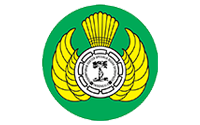CONGENITAL SCOLIOSIS: AN ARTICLE REVIEW
Downloads
Background: Congenital Scoliosis (CS) defined as vertebral lateral deviation which forms during the intrauterine embryonic phase, carrying incidence between 0,5-1 per 1000 births. Mortality rate increases in untreated case, especially due to pulmonary problem (40%).
Contents: CS can range from hemivertebrae (HV) which may be single or multiple, vertebral bar with or without HV, block vertebrae, wedge shaped or butterfly vertebrae. The risk factors for progression include: type of defect, site of defect, and the patient's age. Plain radiographs remain standard diagnosis. MRI evaluation should be considered. The goal of managing CS is to obtain a balanced trunk and spine while maintaining as much normal spinal growth as possible and preventing neural deficit. Non-operative management is including observation, brace, and traction. The operative procedures are broadly divided into (a) those preventing further deformity: in situ fusion, convex hemiepiphysiodesis, and HV excision, (b) those that correct the present deformity: hemiepiphyseodesis & hemiarthrodesis, single & dual growing rods, HV excision, and reconstructive osteotomy.
Conclusion: The treatment of CS remains one of the more challenging aspects of pediatric orthopaedic surgery. Operative treatment should be reserved for patients whom non-operative management didn't meet the criteria or failed.Mo F, Cunningham ME. Pediatric scoliosis. Curr Rev Musculoskelet. 2011; 4(4):175-182
Smith JS, Kasliwal MK, Crawford A, Shaffrey CI. Outcomes, expectations, and complications overview for the surgical treatment of adult and pediatric spinal deformity. Spine Deformity Preview Issue. 2012; 4-14
Kashani FO, Hasankani, EG, Baradaran A, Baghban N. Clinical outcomes of surgery in young patients with spinal deformity. Razavi Int J Med. 2015; 2(4): E23878
Cheung JYP. Focus on management of early-onset scoliosis. The British Editorial Society of Bone and Joint Surgery. 2013
Louis ML, Gennari JM, Loundou AD, et al. Congenital scoliosis: a frontal plane evaluation of 251 operated patients 14 years old or older at follow-up. Orthopaedic & Traumatology: Surgery & Research. 2010; 96: 741-747
Giampietro PF. Congenital and idiopathoc scoliosis: clinical and genetic aspects. Scientifica. 2012. Article ID 152365. http://dx.doi.org/10.6064/2012/152365
Fletcher ND, McClung A, Rathjen KE, Denning JR, Browne R, Johnston JE. Serial casting as a delay tactic in the treatment of moderate-to-severe early-onset scoliosis. J. Peiatr Orthop. 2012; 00:000-000
Mik G, Drummond DS, Hosalkar HS, et al. Diminished spinal cord size associated with congenital scoliosis of the thoracic spine. J Bone Joint Surg Am. 2009; 91:1698-704
Pediatric Orthopaedic Society of North America. Congenital scoliosis. 2015
Batra S, Ahuja S. Congenital Scoliosis: Management and Future Directions. Acta Orthop. Belg. 2008; 74: 147-160
Debnath UK, Goel V, Harshavardhana N, JK Webb. Congenital scoliosis - quo vadis? Indian J Orthop. 2010 April-June; 137-147
Asghar J. Congenital scoliosis. 2012. http://www.orthopaedicsone.com/display/Main/Congenital+Scoliosis
McMaster JM, Mc Master ME. Prognosis for congenital scoliosis due to a unilateral failure of vertebral segmentation. J Bone Joint Surg Am. 2013; 95:972-9
Shah SA, Song Kit. Chapter 18: Congenital Scoliosis. 2013.
Redding GJ. Pulmonary review, early onset scoliosis: a pulmonary perspective. Spine Deformity. 2014; 2: 425-429
Hui H, Luo ZJ, Yan M, Ye ZX, Tao HR, Wang HQ. Non-Fusion and Growing Instrumentation in The Correction of Congenital Spinal Deformity Associated with Split Spinal Cord Malformation: An Early Follow-Up Outcome. Eur Spine J. 2013; 22: 1317-1325
Hedequist D, Emans J. Congenital Scoliosis. J Am Acad Orthop Surg. 2004; 12: 266-275
Cheneau J, Chekryzhev D, Mesentsev A, Petrenko D. The treatment of the congenital scoliosis by cheneau's brace: summary of the first experience. Scoliosis. 2009, 4(Suppl 1):O60
Grivas TB. European braces for conservative scoliosis treatment. InTech. 2012. http://www.intechopen.com/books/human-musculoskeletal-biomechanics/european-braces-for-conservativescoliosis-treatment
Winter RB, Lonstein JE. Ultra-long-term follow-up of pediatric spinal deformity problems: 23 patients with a mean follow-up of 51 years. J Orthop Sci. 2009; 14: 132-137
Kaspiris A, Grivas TB, Weiss HR, Turnbull D. Surgical and conservative treatment of patients with congenital scoliosis: α search for long-term results. Scoliosis. 2011; 6:12
Alanay A, Dede O, Yazici M. Convex instrumented hemiepiphysiodesis with concave distraction: a preliminary report. Clin Orthop Relat Res. 2012; 470:1144–1150
Wang S, Zhang J, Qiu G, Li S, Yu B, Weng X. Posterior hemivertebra resection with bisegmental fusion for congenital scoliosis: more than 3 years outomes and analysis of unanticipated surgeries. Eur Spine J. 2013; 22: 387-393
Zhang J, Shengru W, Qiu G, Yu B, Yipeng W, Luk KDK. The efficacy and complications of posterior hemivertebra resection. Eur Spine J. 2011; 20: 1692-1702
Wang L, Song Y, Pei F, et al. Comparison of one-stage anteroposterior and posterior-alone hemivertebrae resection combined with posterior correction for hemivertebrae deformity. Indian Journal of Orthopaedics. 2011; 45: 492-499
Akbarnia, BA. Management Themes in Early Onset Scoliosis. J Bone & Joint Surg. 2007; 89-A: 42-54
Dede O, Motoyama EK, Yang CI, et al. Pulmonary and radiographic outcomes of VEPTR (vertical expandable prosthetic titanium rib) treatment in early-onset scoliosis. J Bone & Joint Surg. 2014; 96-A: 1295-302
- The author acknowledges that the copyright of the article is transferred to the Journal of Orthopaedi and Traumatology Surabaya (JOINTS), whilst the author retains the moral right to the publication.
- The legal formal aspect of journal publication accessibility refers to Creative Commons Attribution-Non Commercial-Share Alike 4.0 International License (CC BY-NC-SA).
- All published manuscripts, whether in print or electronic form, are open access for educational, research, library purposes, and non-commercial uses. In addition to the aims mentioned above, the editorial board is not liable for any potential violations of copyright laws.
- The form to submit the manuscript's authenticity and copyright statement can be downloaded here.
Journal of Orthopaedi and Traumatology Surabaya (JOINTS) is licensed under a Creative Commons Attribution-Non Commercial-Share Alike 4.0 International License.



























 Journal Orthopaedi and Traumatology Surabaya (JOINTS) (
Journal Orthopaedi and Traumatology Surabaya (JOINTS) (